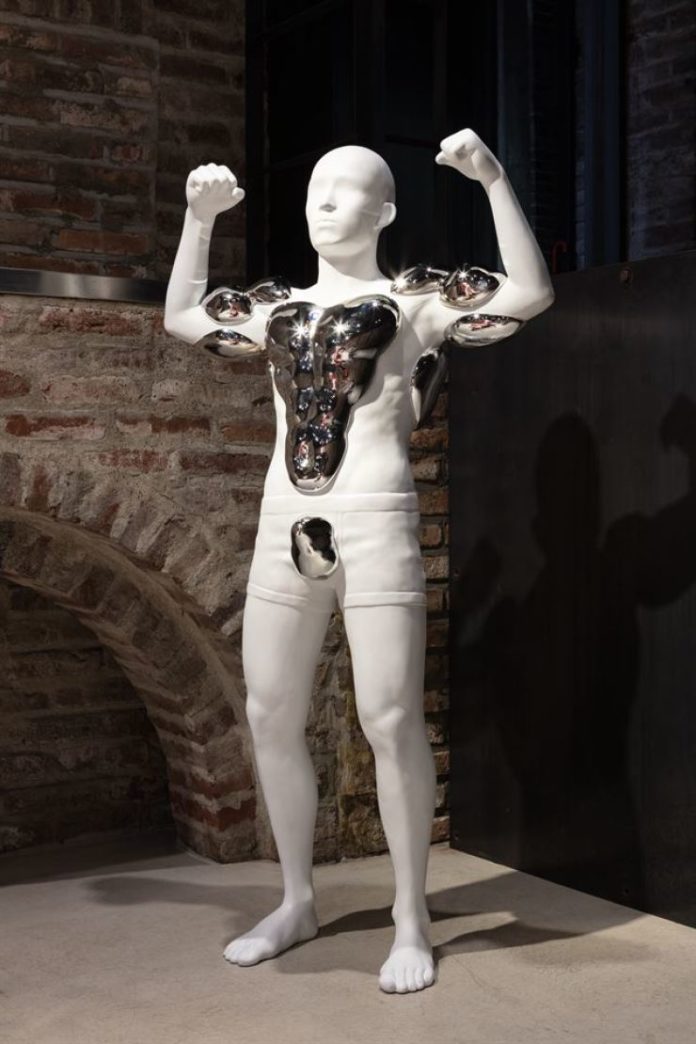 |
| “Bulky” (2021) by Choi Ha-neyl / Courtesy of Arario Museum |
By Park Han-sol
 |
| Artist Choi Ha-neyl / Courtesy of Arario Museum |
Problems with body image can often become a source of insecurity. One way people dispel this lack of self-confidence is by bulking up. Choi Ha-neyl’s sculpture “Bulky” achieves this interestingly through shimmering, chrome-plated muscles adorning specific body parts.
To Choi, the sculpting process of adding chunks after chunks of materials to gradually build up the model’s size reminded him of the obsession among many members of the gay community in becoming more muscular.
And that wasn’t the only connection the queer artist drew in his work. Just as how sexual minorities still remain on the fringes of Korean society, he felt that the genre of sculpture continues to be marginalized in its art world.
“In Korea, contemporary art trends are often set or guided by national and public art institutions, whose focus has shifted more toward new media and digital works,” the artist said at the Arario Museum in Space in downtown Seoul, where his solo exhibition “Bulky” is held. “As a sculptor who focuses on creating large-scale pieces, I personally feel that the country’s market for sculpture art is still weak.”
He chose, therefore, to fuse these two keywords ― LGBTQ narrative and sculpture ― through his series of works to increase their visibility in the art scene. It’s his own way of “bulking up” the social visibility of both.
Although the 30-year-old artist’s past works have captured a wide range of socially marginalized figures ― including transgender people, migrant workers, single mothers and refugees ― he decided to shift his focus specifically to Korea’s gay culture for this exhibition.
Choi’s minimalist sculpture and photo installations on display visualize suggestively the “gayish” elements he has noticed within Korea’s folklore, popular culture and sports, thereby actively reimagining the presence of queerness in our everyday lives.
 |
| An installation view of Choi Ha-neyl’s exhibition “Bulky” at the Arario Museum in Space in central Seoul / Courtesy of Arario Museum |
In the legend of Yi Cha-don of the Silla Dynasty (57 BCE―935 CE), a martyr who agreed to be beheaded for his Buddhist faith, it is said that the moment the sword slashed his neck, “white breast milk” gushed out instead of blood.
Choi infused his own queer imagination into such an inexplicable myth, creating a white beheaded bust of Yi, but with three faces ― birthed through the liquid that can represent both semen and breast milk. This was his method of “polluting” Korea’s traditions through gay culture, he explained.
In his “Bulky_sex (combine)” and “Bulky_fusion” series, this effort moves on to the contemporary scenes of sports and popular culture. Witnessing matches of Japan’s jiu jitsu and Korea’s ssireum, Choi couldn’t help but feel that the intimate physical contact and the entanglement of two male bodies were “gay.”
“As I saw the two human bodies being combined into one big mass, I thought it would be interesting to portray them in my works with a queer touch,” he said.
Such a fusion of bodies was also witnessed in many Japanese robot anime that the sculptor grew up watching.
“Most of the robots featured are identified as male, and seeing those figures fusing with one another to become a bigger male to fight evil felt gay to me. Not many really caught onto that at the time they were watching the show, but it was still there.”
Through his sculptures, which fuse together different materials and shapes into one monstrous chunk to explore such idea, the artist has brought the presence of queerness or gayness to the surface in everyday reality.
 |
| “Welcome to my page!” (2021) by Choi Ha-neyl / Courtesy of Arario Museum |
One other piece that offers a glimpse into part of the Korean gay community’s lifestyle to the audience is “Welcome to my page!” The artist took photos of his personified sculpture ― which he named Matthew ― and created an OnlyFans page for him. OnlyFans is a subscription-based content-sharing platform, where users can sell their photos and videos ― including those of a sexually explicit nature ― and according to Choi, in Korea, it has been largely favored by gay men.
Scanning a large QR code printed in the installation will take the viewers to Matthew’s OnlyFans page, allowing them to “appreciate his bodies” from various angles.
“I think that a platform like OnlyFans can only exist in a country with a prevalent sense of individualism (in a positive way.) Whatever others do, they don’t care and try not to intervene. So, when I heard that some members of the Korean gay community began using the website to sell their own content, I didn’t find it to be a bad thing. It was an indication that there were men who have freed themselves from others’ judgment,” he noted.
“Queer art is bound to be associated with queer liberation. In Korea, a large sector of the LGBTQ community still remains invisible, and as a result, many queer art practices have been focusing on increasing their visibility. That is one of the purposes of my works but I’m also constantly looking for ways to go beyond that.”
The exhibition “Bulky” runs through March 6, 2022, at the Arario Museum in Space.








